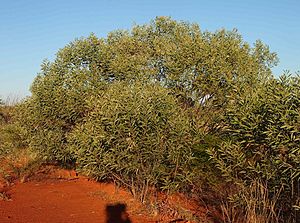Ganambureng facts for kids
Quick facts for kids Ganambureng |
|
|---|---|
 |
|
| Scientific classification | |
| Genus: |
Acacia
|
| Species: |
gonoclada
|
 |
|
| Occurrence data from AVH | |
Acacia gonoclada, also known as ganambureng, is a special tree or shrub found only in northern Australia. It belongs to a big family of plants called Acacia. This plant is endemic, which means it naturally grows only in this specific part of the world.
Contents
What Does Ganambureng Look Like?
This plant usually grows to be about 0.5 to 4 metres (2 to 13 ft) tall, which is like a small tree or a large bush. It has smooth bark that can be reddish-brown or grey. Its branches are olive-green to brown and have a bit of an angular shape.
Instead of regular leaves, most Acacia plants, including the ganambureng, have something called phyllodes. These are like flattened leaf stems that do the job of leaves. The phyllodes of the ganambureng are flat and evergreen, meaning they stay green all year. They are shaped like an oval or a spoon, usually 5 to 13.5 cm (2.0 to 5.3 in) long and 8 to 33 mm (0.31 to 1.30 in) wide. They are narrower and curve upwards near their base and have two or three clear main veins.
Flowers and Seed Pods
The ganambureng blooms from May to September, showing off bright yellow flowers. These flowers grow in cylindrical spikes, which are like long, thin clusters. Each spike can be 1 to 5 cm (0.39 to 1.97 in) long.
After the flowers, flat, linear seed pods start to form. These pods are thin and shiny, and they are slightly squeezed between each seed. They are usually 2 to 6 cm (0.79 to 2.36 in) long and get narrower towards both ends. Inside these pods, you'll find black seeds arranged lengthwise. The seeds are small, about 3 to 4 mm (0.12 to 0.16 in) long, and have an open, narrow mark on them.
How Ganambureng Got Its Name
The first time this plant was officially described was in 1859 by a botanist named Ferdinand von Mueller. A botanist is a scientist who studies plants. He wrote about it in a scientific journal.
Later, in 1987, another botanist named Leslie Pedley reclassified it, giving it a different scientific name, Racosperma gonocladum. However, in 2001, it was moved back to the Acacia group, where it is known as Acacia gonoclada today.
Where Ganambureng Grows
This plant is found in tropical areas across northern Australia. You can see it in the Kimberley region of Western Australia, throughout the Top End of the Northern Territory, and into central Queensland. It prefers to grow in shallow, stony soils or loamy soils, which are a mix of sand, silt, and clay.

